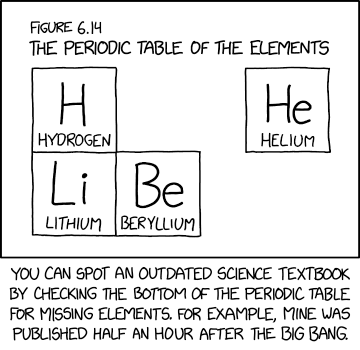Outdated Periodic Table

Researchers claim to have synthesized six additional elements in the second row, temporarily named 'pentium' through 'unnilium'.

Researchers claim to have synthesized six additional elements in the second row, temporarily named 'pentium' through 'unnilium'.
This comic shows figure 6.14 from a science text book, which displays The periodic table of the elements, but with only the first four elements (hydrogen, helium, lithium and beryllium) shown. Randall claims in the caption that you can use such charts to date a publication based upon the elements present or missing. While this is true in a sense - for example, Nihonium, Moscovium, Tennessine and Oganesson were first discovered in 2003 and named in 2016, thus charts made before 2016 would have the systematic element names Ununtrium, Ununpentium, Ununseptium and Ununoctium and completely absent before 2003 - Randall injects humor by taking it to the extreme and showcasing a periodic table from a book published just half an hour after the Big Bang, at which time those four elements were the only ones present.
From about 10 seconds until about 20 minutes after the Big Bang, the phase that is known as the Big Bang nucleosynthesis occurred. At that time, hydrogen ions (single protons) provided for helium in abundance and traces of lithium. Some berylium-7 was also formed, which is an unstable isotope having a half life of 53 days. Randall's science book was published when those four elements were the only ones in existence, even though this would be absurd since no life as we know it could exist with only these four elements to write and publish the book; perhaps it is why Randall's mysterious textbook seems and manages to reflect the direct state of elements existing in nature, even though the real life periodic table was slowly filled out based on what could be easily found and later synthesized. For example, despite helium being one of the first elements to exist, and still one of the most common in the universe (roughly 24%, by mass, with hydrogen being around 75% and every other element combined being the remainder), it did not appear in the earliest periodic tables.
The title text refers to how yet-undiscovered elements are given a systematic element name as a temporary name, until a more permanent name is decided upon. The names are based upon a standard group of Greek and Latin roots that read out the decimal digits of an element's unique atomic number (i.e., the number of protons) and adding "-ium" to the end. The claim in the title text is that, in the textbook with the figure, researchers claim they have synthesized six additional elements in the second row, temporarily named 'pentium' (atomic number "5") through to 'unnilium' ("one zero", or "10"). In reality, all these elements are well known as Boron, Carbon, Nitrogen, Oxygen, Fluorine and Neon. The word "Pentium" is also the brand name of some computer hardware which may contain some amount of boron.